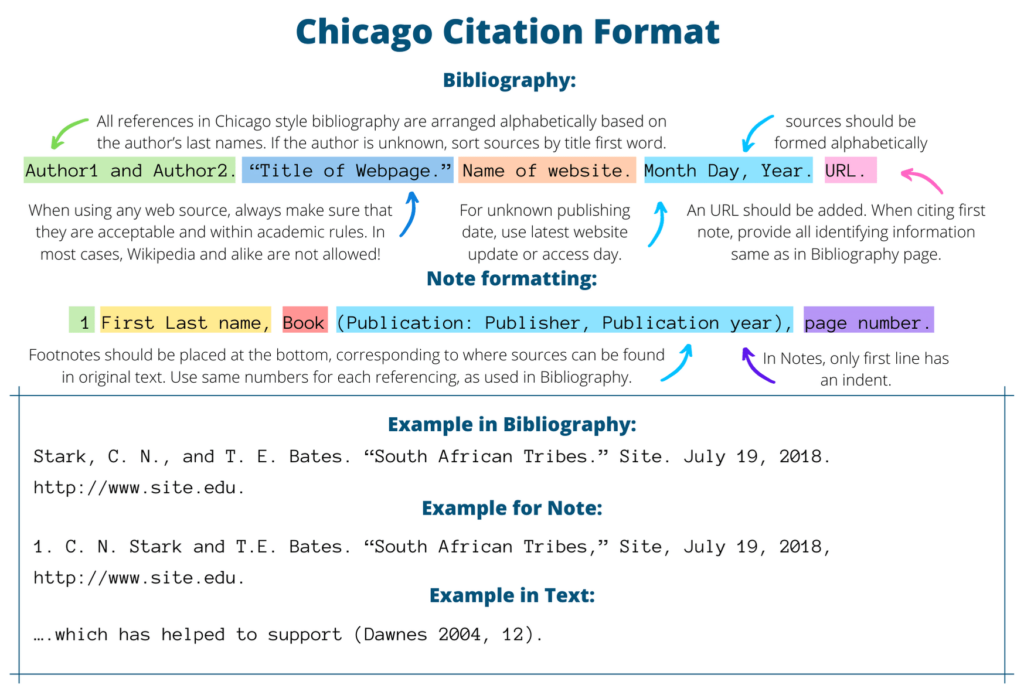Footnotes, Notes and In-Text Citing in Chicago Format
In our Chicago citation guide, we provide both citing patterns, so one can see specifics when using notes. An important point is that when a certain source is mentioned, a note or footnote should be placed with the corresponding number. A superscript numbering is used for such purposes. When using notes for a second or any subsequent time, full publication details are not included, as one will see in templates.
Footnote or an endnote citation:
When using notes for a second or any subsequent time, full publication details are not included, as one will see in templates.
Footnote or an endnote citation:
1 First Last name, Book (Publication: Publisher, Publication year), page number.
If there is one author
Last, First name. Book. Publication location: Publisher, year.
When citing in-text, first source mentioning only implements corresponding number. In following parenthetical citing, use these examples:
….which has helped to support (Dawnes 2004, 12).
In a 2004 report, Dawnes (112) has helped to support social research based on…
Use the Chicago book chapter citation generator when you need to refer to a specific part of a book.
Two authors citation
(Kern and Wilders 2002, 121)
Three authors citation
(Curtis, Frank, and Zachary 2012, 34)
Four or more authors in Chicago citation
(Jansen et al. 2017, 213)
Organization as an author citation
Provide organization, source title or abbreviation:(NATO 2000, 134)
(“Polar Bears Safety” 2004, 12)
Unknown author
(“Red Tower History” 2015, 32)
Unknown page number
(Harris 2016, para. 2:34)
Unknown date citing
(Hicks n.d., 118)
Multi-volume source
(Ryan 2005, 2:35)
Authors with same last name
(Clang R. 2010 and Clang S. 2011)
Two or more works by same author, same year
Add corresponding letter after publishing year:(Marx 2010a) and (Marx 2010b)
Multiple sources in same citation
(Jagger 2011, 21; Gilmour 2012, 738)
Indirect in-text citation
(quoted in Paster 2015, 12)
Periodicals
Lectures and presentations
Lecturer. “Lecture.” Lecture, Location of Lecture, Month Day, Year of Lecture.
Leiton, Warren. “Sociology Introduction.” Lecture, London, July 17, 2005.
For notes:
1. Lecturer, “Lecture” (lecture, Location of Lecture, Month Day, Year of Lecture).
1 Warren Leiton, “Sociology Introduction” (lecture, London, July 17, 2005).
Following notes:
Leiton, “Sociology Introduction.”
Academic Sources / Interviews
Governmental documents
If source cited is in print, reference it like any other document, dissertation or report. An URL should be added. When citing first note, provide all identifying information same as in Bibliography page.Seattle Forensic Bureau. Bureau of Criminology. Criminal Database Template. Seattle,
WA: Seattle Dept. of Criminology, Division of Forensic Research, Bureau of Investigation, 2006. http://www.site.org/.
Interviews
Author. “Interview’s title.” Interview by Name, Last Name. Program,
Organization, Date. Audio, Time (xx:xx). URL.
King, Larry. “Cold War Ethics.” Interview by William James. Tonight Host Show, CNBC, April 7,
2011. Audio, 32:26. http://www.site.com
For note:
1 Larry King, “Cold War Ethics,” Interview by William James, Tonight Host Show, CNBC,
April 7, 2011, Audio, 32:26. http://www.site.com
For notes that follow:
1 King, interview.
Why Use Chicago Style Bibliography Generator
Writing an academic assignment in Sociology or Arts paper, even most common ideas and arguments should be supported by academic sources to make research reliable. A reason why Chicago citing is important is the avoidance of plagiarism. Generally, research papers can include from 10 to 15 diverse sources that include books, academic journals, and different media. It is no wonder that even the best college students easily get confused and spend hours with diverse sources as they cite Chicago style. To make citation easier and faster, we offer Chicago citation maker as it helps with:- Automatic and manual citation styles where available information can be entered by hand.
- Choosing between resource types.
- “Date and Author” and “Notes” citations generated.
- Chicago citation generator helps to avoid plagiarism as machine documents each source in correct way.